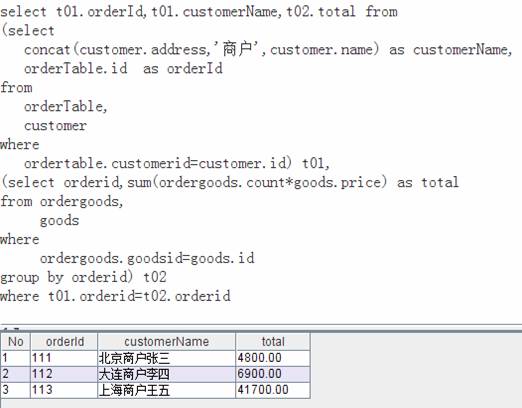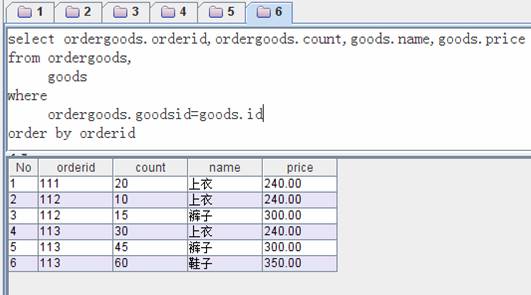數據庫設計三范式應用實戰
問題:如何將下表中列出的訂單信息存入到關系數據庫中
客戶名 總價值 商品列表
北京商戶張三 1000元 上衣:20
大連商戶李四 1500元 上衣:10;褲子:15;
上海商戶王五 7500元 上衣:30�;褲子:45;鞋子:60;
粗略設計方案
根據訂單上三欄內容,擬用一個表來存儲訂單信息����,此表稱為Order表,字段如下:
Customer:可變字符型,用于存儲客戶地址姓名等信息。
Total:數字類型���,用于存儲一個訂單的總商品價值
GoodsList:可變字符型,用于存儲商品名和商品數量
這樣的設計是否符合數據庫設計三范式呢?可以一條條對照一下����。
數據庫設計三范式
范式(Normal Form)共有五種���,但第四和第五種難于實現�,并非必要。前三種標準格式為:
第一范式(1NF)要求信息必須是原子級的�,信息不可再分�。
第二范式(2NF)要求數據符合第一范式的標準����,另外數據元素被組織成組,消除了冗余的數據�。每個組包含一個主鍵和非關鍵數據,非關鍵數據必須在功能上依賴于主鍵���。
第三范式(3NF)要求數據元素符合第二范式的標準,同時非關鍵數據不能包含依賴性。
個人對其的總結:1.信息不可分;2.以分組消除冗余數據,組內有主鍵作為唯一標識����;3.組內部的非主鍵數據不能相互依賴。
現在來看看粗略設計方案是否符合數據庫設計三范式
1.Customer和GoodsList列可分,不符合第一范式。
2.無主鍵�,且三大基本信息都不依賴于主鍵���,沒有進行合適分組���,不符合第二范式。
3.total列明顯依賴于GoodsList列,不符合第三范式�。
因為粗略設計方案不符合三大范式�,我們有必要對其進行修改。
修改后的第二次設計方案
首先為了滿足第一范式����,將三大數據列細分如下:
customerName:用于存儲客戶名稱
customerAddress:用于存儲客戶地址
total :用于存儲商品總價值
Goods1:訂單商品一
GoodsCount1:訂單商品一的數量
Goods2:訂單商品二
GoodsCount2:訂單商品二的數量
Goods3:訂單商品三
GoodsCount3:訂單商品三的數量
到此����,信息已經不可再分,這樣的方案滿足了第一范式的要求���。
第二次設計方案存在的問題
第二次設計方案雖然滿足了范式一����,但是還有以下問題:
1.三個訂單商品列和訂單數量列高度相似。
2.如果客戶訂單商品類別確定在三種內還可以���,一旦超過只有再增加列,更麻煩的是商品類別數量不確定����。
3.各個字段作用差別很大,似乎不該放在同一張表的同一行中�。
上述問題說明第二次設計方案還有待改造,讓我們再來看看它是否合乎第二���,三范式。
第二范式及解釋
第二范式(2NF)要求數據符合第一范式的標準,另外數據元素被組織成組,消除了冗余的數據�。每個組包含一個主鍵和非關鍵數據���,非關鍵數據必須在功能上依賴于主鍵。
上面這段話中����,組實際上就是“數據表”的意思���,第二范式告訴我們,應該把數據元素按功能分開����,分別存儲到不同表中,而且每個表都該含有一個主鍵,非關鍵列在功能上依賴于關鍵列���。
第三范式
第三范式(3NF)要求數據元素符合第二范式的標準����,同時非關鍵數據不能包含依賴性�。
第二次設計方案中���,總價值total是依賴于商品類別和商品數量的。我們必須取消這樣的非關鍵列之間的依賴性���。
通過觀察我們可以發現���,總價值=商品單價*商品數量的總和,這樣,總價值這一列就不需要存在了����,直接計算得出即可。
接下來形成了第三次設計方案
訂單表orderTable
id:主鍵,訂單流水id
customerId:下訂單的客戶id����,客戶表Id的外鍵
訂單商品表ordergoods
id:主鍵
orderId:訂單表id的外鍵
goodsId:商品表id的外鍵
count:商品數量
商品表goods:
id:主鍵
name:商品名
price:單價
客戶表customer:
id:主鍵
name:客戶名
address:客戶地址
諸表建表語句
 create table customer(
create table customer(
 id int(10) primary key not null,
id int(10) primary key not null,
 name VARCHAR(255),
name VARCHAR(255),
 address VARCHAR(255)
address VARCHAR(255)
 )
)

 create table goods(
create table goods(
 id int(10) primary key not null,
id int(10) primary key not null,
 name VARCHAR(255),
name VARCHAR(255),
 price DOUBLE(10,2)
price DOUBLE(10,2)
 )
)

 create table orderTable(
create table orderTable(
 id int(10) primary key not null,
id int(10) primary key not null,
 customerid int(10) not null,
customerid int(10) not null,
 foreign key(customerid) references customer(id)
foreign key(customerid) references customer(id)
 )
)

 create table ordergoods(
create table ordergoods(
 id int(10) primary key not null,
id int(10) primary key not null,
 orderid int(10) not null,
orderid int(10) not null,
 goodsid int(10) not null,
goodsid int(10) not null,
 count int(10),
count int(10),
 foreign key(orderid) references orderTable(id),
foreign key(orderid) references orderTable(id),
 foreign key(goodsid) references goods(id)
foreign key(goodsid) references goods(id)
 )
)


插值語句
 insert into customer ( id, name, address ) values ( '1', '張三', '北京' )
insert into customer ( id, name, address ) values ( '1', '張三', '北京' )
 insert into customer ( id, name, address ) values ( '2', '李四', '大連' )
insert into customer ( id, name, address ) values ( '2', '李四', '大連' )
 insert into customer ( id, name, address ) values ( '3', '王五', '上海' )
insert into customer ( id, name, address ) values ( '3', '王五', '上海' )

 insert into goods ( id, name, price ) values ( '11', '上衣', '240' )
insert into goods ( id, name, price ) values ( '11', '上衣', '240' )
 insert into goods ( id, name, price ) values ( '12', '褲子', '300' )
insert into goods ( id, name, price ) values ( '12', '褲子', '300' )
 insert into goods ( id, name, price ) values ( '13', '鞋子', '350' )
insert into goods ( id, name, price ) values ( '13', '鞋子', '350' )

 insert into ordertable ( id, customerid ) values ( '111', '1' )
insert into ordertable ( id, customerid ) values ( '111', '1' )
 insert into ordertable ( id, customerid ) values ( '112', '2' )
insert into ordertable ( id, customerid ) values ( '112', '2' )
 insert into ordertable ( id, customerid ) values ( '113', '3' )
insert into ordertable ( id, customerid ) values ( '113', '3' )

 insert into ordergoods ( id, orderid, goodsid, count ) values ( '1111', '111', '11', '20' )
insert into ordergoods ( id, orderid, goodsid, count ) values ( '1111', '111', '11', '20' )
 insert into ordergoods ( id, orderid, goodsid, count ) values ( '1112', '112', '11', '10' )
insert into ordergoods ( id, orderid, goodsid, count ) values ( '1112', '112', '11', '10' )
 insert into ordergoods ( id, orderid, goodsid, count ) values ( '1113', '112', '12', '15' )
insert into ordergoods ( id, orderid, goodsid, count ) values ( '1113', '112', '12', '15' )
 insert into ordergoods ( id, orderid, goodsid, count ) values ( '1114', '113', '11', '30' )
insert into ordergoods ( id, orderid, goodsid, count ) values ( '1114', '113', '11', '30' )
 insert into ordergoods ( id, orderid, goodsid, count ) values ( '1115', '113', '12', '45' )
insert into ordergoods ( id, orderid, goodsid, count ) values ( '1115', '113', '12', '45' )
 insert into ordergoods ( id, orderid, goodsid, count ) values ( '1116', '113', '13', '60' )
insert into ordergoods ( id, orderid, goodsid, count ) values ( '1116', '113', '13', '60' )


查詢訂單總價值
 select t01.orderId,t01.customerName,t02.total from
select t01.orderId,t01.customerName,t02.total from
 (select
(select
 concat(customer.address,'商戶',customer.name) as customerName,
concat(customer.address,'商戶',customer.name) as customerName,
 orderTable.id as orderId
orderTable.id as orderId
 from
from
 orderTable,
orderTable,
 customer
customer
 where
where
 ordertable.customerid=customer.id) t01,
ordertable.customerid=customer.id) t01,
 (select orderid,sum(ordergoods.count*goods.price) as total
(select orderid,sum(ordergoods.count*goods.price) as total
 from ordergoods,
from ordergoods,
 goods
goods
 where
where
 ordergoods.goodsid=goods.id
ordergoods.goodsid=goods.id
 group by orderid) t02
group by orderid) t02
 where t01.orderid=t02.orderid
where t01.orderid=t02.orderid查詢結果

查詢訂單貨物細節
 select ordergoods.orderid,ordergoods.count,goods.name,goods.price
select ordergoods.orderid,ordergoods.count,goods.name,goods.price
 from ordergoods,
from ordergoods,
 goods
goods
 where
where
 ordergoods.goodsid=goods.id
ordergoods.goodsid=goods.id
 order by orderid
order by orderid

查詢結果
